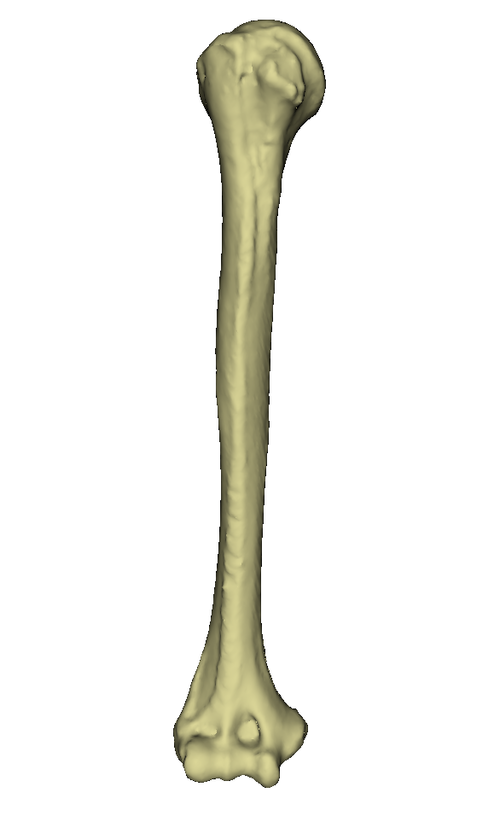Humerus
Structure of the humerus
The humerus is articulately connected to Scapula, Ulna and Radius.
It consists of the corpus and a proximal and distal extremitas. The proximal end forms the caput humeri (1) with the adjacent neck, collum humeri. It appears slightly retracted and is also called collum anatomicum. The distal end is formed by the condylus humeri (3).
On the anterior surface of the extremitas proximalis is laterally the tuberculum majus (4) and medially the tuberculum minus (5). Between the two there is a strong depression, the Sulcus intertubercularis (6), which serves as a slide rail for the tendon of the Caput longum of the M. biceps brachii.
The Sulcus n. radialis (7) is located at the posterior surface of the corpus humeri. At the distal Extremitas there is medially the stronger bone projection, Epicondylus medialis (8), and laterally the weaker Epicondylus lateralis (9).
Trochlea humeri (10) and Capitulum humeri (11) form the Condylus humeri and serve as an articulated connection with the forearm bones. Medially from the Trochlea humeri runs a shallow channel, the Sulcus n. ulnaris (12). The Fossa olecrani (13), a deep pit, is located above the Trochlea at the posterior surface of the humerus.
The humerus is torqued at its proximal end, i.e. the caput is twisted about 20° backwards from the axis by the epicondyli humeri (torsion). Between the longitudinal axis of the humerus and the caput there is an average angle of 130°, while at the distal end, between the transverse joint axis and the longitudinal axis of the humerus shaft, there is an angle of 76° to 89°.
The bony socket (Cavitas glenoidalis) of the Articulatio humeri, a ball joint, is considerably smaller than the head of the humerus. The socket is enlarged by a fibrous cartilaginous joint lip, Labrum glenoidale. The surface of the Cavitas glenoidalis is approx. 6 sqcm. The weight of the upper extremity is about 4 kg. Since there are no stronger ligaments, the muscles surrounding the joint must secure it. This is known as a muscle-secured joint. The so-called "rotator cuff" is part of this muscular securing and especially strengthens the joint capsule.
The Caput humeri (1) is approximately spherical. The synovial joint capsule is attached to the Labrum glenoidale of the scapula. It extends like a bag along the intracapsular tendon of the long biceps head and embraces it with a vagina synovialis intertubercularis, which is located in the sulcus intertubercularis (5).
The Caput humeri is approximately spherical. The synovial joint capsule is attached to the labrum glenoidale of the scapula.
Movements in three degrees of freedom are possible. It is called abduction and adduction, whereby the resting position of the caput humeri in the scapula plane is assumed. There is the anteversion, the lifting of the arm forward and its counter-movement, the retroversion. By a rotatory component, a compound movement, the circumduction or the circling, results with the participation of the aforementioned movements, whereby the arm practically describes a cone mantle.
Abduction movements always result in a co-motion of the scapula; excessive co-motion of the scapula occurs with an abduction of more than 90 degrees (elevation).
weiterführende Links
